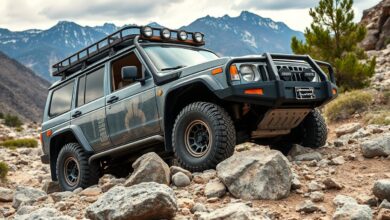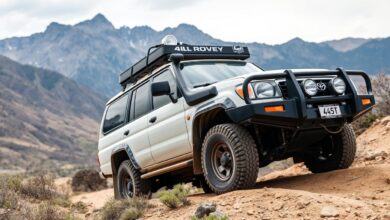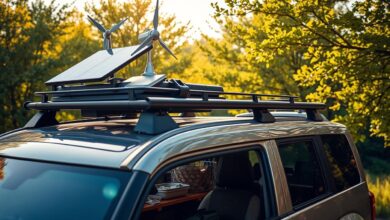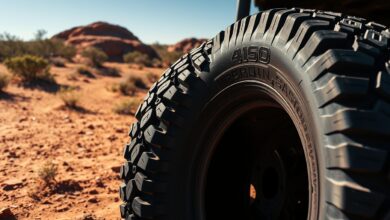The Best Recovery Tracks and Chains for 4WD Vehicles
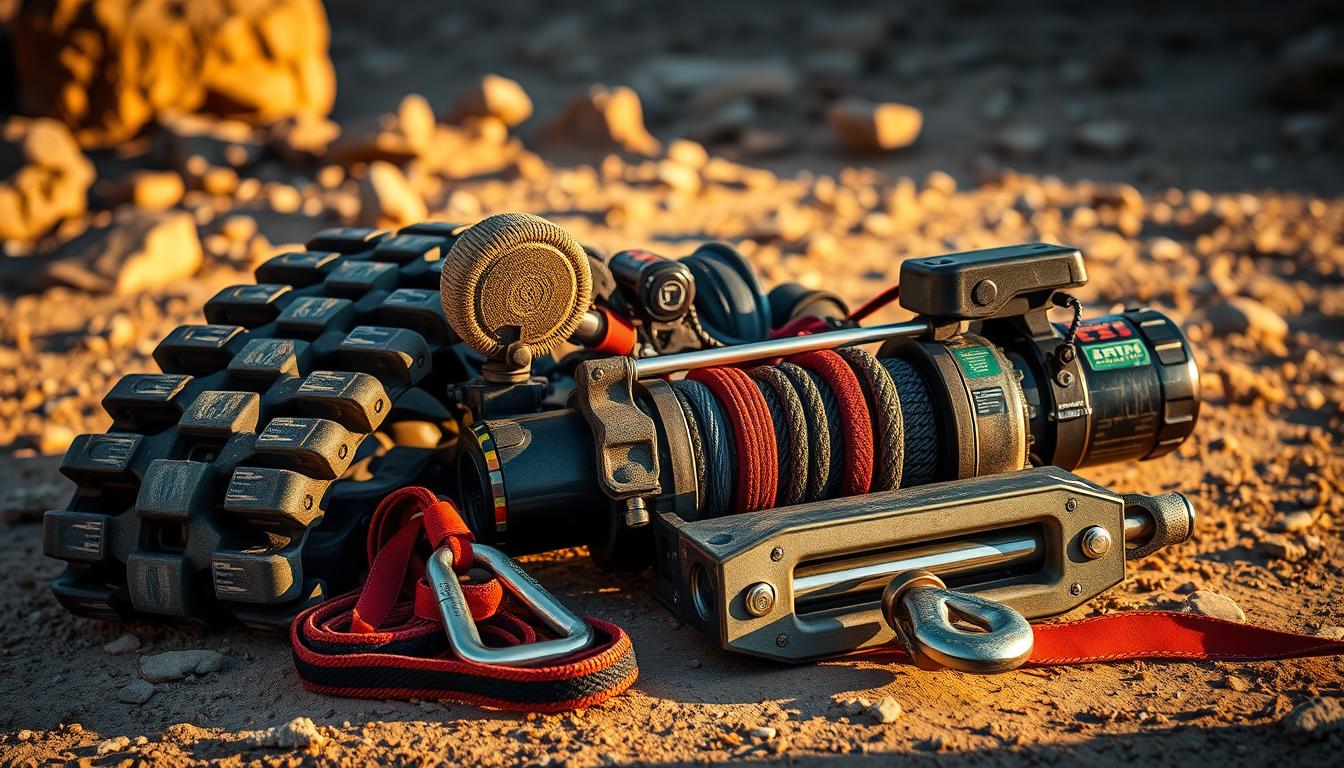
Off-roading in Australia is an exciting adventure. But, it can also mean getting stuck in mud, sand, or snow. That’s where off-road recovery gear comes in. It gives your 4WD vehicle the traction it needs to get back on track.
Recovery tracks and chains are key for serious off-roaders. They provide a reliable way to regain traction and overcome obstacles. Whether you’re on rugged bush tracks or extreme off-road conditions, the right gear is essential. It can turn a successful adventure into a costly rescue operation.
Key Takeaways
- Recovery tracks and chains are vital for 4WD vehicles venturing into challenging off-road terrain.
- Off-road recovery gear helps prevent vehicles from getting stuck in mud, sand, or snow.
- The right recovery equipment can significantly enhance the safety and success of off-road adventures.
- Understanding the different types of recovery tracks and chains is key for choosing the best gear.
- Investing in high-quality recovery gear can save time and money in the long run.
Understanding Recovery Tracks for 4WD
Recovery tracks are key for 4WD owners facing tough terrains. They offer a stable base for tires in mud, sand, or snow.
What Are Recovery Tracks?
Recovery tracks, also called traction mats, are made from strong materials like plastic or rubber. They help 4WD vehicles get traction and move when stuck. High-quality recovery gear is vital for off-roading, and recovery tracks are a key part of it.
How Recovery Tracks Work
When a 4WD gets stuck, recovery tracks are placed under the tires. They give a firmer surface for the vehicle to drive on. This helps the vehicle regain traction and move out of tough terrain.
Benefits of Using Recovery Tracks
Using recovery tracks boosts safety and reduces vehicle damage risk. They also let you tackle tough terrains with more confidence. Recovery tracks are super useful in off-road areas where grip is hard to find.
| Material | Durability | Traction |
|---|---|---|
| Rubber | High | Excellent |
| Plastic | Medium | Good |
Knowing how recovery tracks work and their benefits helps 4WD owners choose the right gear. Investing in top-rated recovery equipment is key for safe and fun off-roading trips.
Chains vs. Tracks: Which to Choose?
For 4WD owners who love off-roading, knowing the difference between chains and tracks is key. Both have their pros and cons, depending on what you need. So, it’s all about what works best for you.
Comparing Performance
Recovery tracks and chains help get a stuck 4WD vehicle back on track. But, they work differently. Recovery tracks offer a solid base, spreading weight evenly to protect your vehicle. Recovery chains, on the other hand, are great for winching or towing in various situations.
Think about where you’ll be recovering. Tracks are best for soft grounds like sand or mud. Chains shine in rocky or steep areas.
Terrain Considerations
The terrain you drive on matters when choosing between chains and tracks. For sandy dunes or muddy paths, durable traction aids like recovery tracks are perfect. They help pull your vehicle out safely without damage.
- Recovery tracks are great for soft terrains like sand, mud, or snow.
- Recovery chains work best in rocky, steep, or uneven terrains.
Cost Factors
Cost is a big deal when picking between chains and tracks. Premium tire chains for 4×4 vehicles might be cheaper but may not last as long as tracks. Tracks might cost more upfront but are better for frequent use.
- Think about how often you’ll use them and the terrain.
- Look at the durability and quality of the gear.
- Consider the long-term cost for your needs.
Top Recovery Tracks on the Market
Off-road recovery has become easier with new recovery tracks technology. For 4WD fans, the right gear is key for tough terrains. These tracks offer grip and stability, helping vehicles get past mud, sand, and rocks.
MAXTRAX Recovery Tracks
MAXTRAX recovery tracks are easy to use and work well. The MAXTRAX MKII Vehicle Recovery Board is top-notch. It’s easy to put on and take off. These tracks give great traction and are tough for off-road use.
Key Features of MAXTRAX Recovery Tracks:
- Easy to deploy and recover
- High-quality, durable construction
- Excellent traction on various surfaces
- Compact design for easy storage
TRED Pro Recovery Tracks
TRED Pro tracks are durable and perform well. They’re made from a strong resin for better grip and can handle heavy loads. Off-road fans like them for their reliability and success.
Benefits of TRED Pro Recovery Tracks:
- Durable glass-filled resin construction
- Superior grip on various terrains
- Easy to use and maneuver
Smittybilt X2O Recovery Tracks
Smittybilt X2O tracks are a strong choice for off-road recovery. They give great traction and are built to last. Smittybilt X2O tracks are a great addition to any 4WD’s recovery kit.
Features of Smittybilt X2O Recovery Tracks:
- Durable construction for long-lasting performance
- Effective traction on challenging terrains
- Easy to deploy and use
Leading Recovery Chains for 4WD
For 4WD vehicles, reliable recovery chains are key for tough terrains. Whether it’s steep hills, muddy paths, or snowy areas, the right chains can mean the difference between being stuck or moving forward.
Hi-Lift Off-Road Chains
Hi-Lift Off-Road Chains are known for their toughness and performance in tough off-road settings. They offer top-notch traction, perfect for 4WD enthusiasts exploring rough terrains. Their strong build means they can handle the toughest off-road recovery tasks.
TIRE-CHAIN Off-Road Chains
TIRE-CHAIN Off-Road Chains are a solid choice for 4WD recovery in tough spots. They’re made for great grip and stability, fitting various terrains like snow and ice. Their simple use and effective traction make them a favorite among off-roaders.
Superwinch Recovery Chains
Superwinch Recovery Chains are a top pick for 4WD fans, known for their strength and dependability. These chains are built for heavy-duty recovery, giving the grip needed to pull your vehicle out of tough spots. Their long-lasting quality makes them a valuable part of your recovery gear.
When picking recovery chains for your 4WD, think about durability, ease of use, and fit with your vehicle. Choosing top-notch chains like Hi-Lift, TIRE-CHAIN, or Superwinch ensures you’re ready for any off-road journey.
Features to Look for in Recovery Gear
Knowing what makes high-quality recovery gear for off-roading is key for 4WD fans. When picking recovery gear, several important factors help ensure you get the right stuff for your adventures.
Weight Capacity and Durability
The weight capacity of your recovery gear is super important. It needs to handle the weight of your vehicle. Durability is also key, as recovery gear faces tough conditions. Choose gear made from strong materials that can handle off-roading’s challenges.
Ease of Use
Ease of use is another big deal. Your recovery gear should be simple to set up and use, even when things get tough. Products like TruckClaws are great because they’re compact, light, and easy to use. They’re a top pick for many 4WD owners.
Storage and Portability
Lastly, think about the storage and portability of your gear. It should fit easily in your vehicle and not take up too much room. Light gear is better because it doesn’t add extra weight to your vehicle. This makes it easier to move around.
By looking at these important features—weight capacity, durability, ease of use, and storage—you can pick off-road recovery gear that fits your needs. This will make your off-roading adventures even better.
Maintenance Tips for Recovery Equipment
To get the most out of your durable traction aids for 4WD vehicles, regular maintenance is key. It keeps your recovery equipment in top shape. This way, it works best when you really need it.
Cleaning Your Recovery Tracks
Recovery tracks can get dirty with dirt, mud, and debris. This dirt can hurt their performance. To clean them, start by hosing off any loose stuff.
Then, use a brush and mild detergent to scrub them. Rinse well and let them dry before you store them.
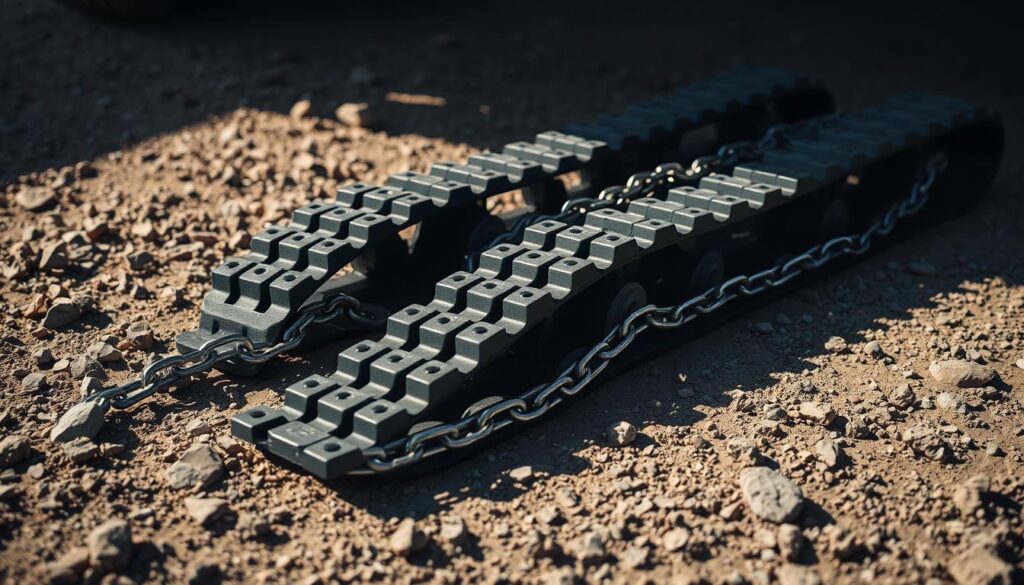
Inspecting Recovery Chains
Checking your recovery chains regularly is a must. Look for rust, broken links, or wear. If you spot any damage, swap out the chain right away. This prevents it from failing when you’re using it.
Don’t forget to oil your recovery chains now and then. This stops rust and keeps them running smoothly.
Storing Recovery Gear Properly
Storing your recovery gear right is important. Keep your top-rated recovery equipment in a dry, clean spot. Avoid direct sunlight. Use bags or containers to keep things tidy and safe.
Before you store, make sure everything is clean and dry. This stops moisture from causing rust or damage.
By keeping up with these maintenance tips, your recovery equipment will stay in great shape. Regular care not only makes your gear last longer. It also keeps you safe on off-road trips.
User Reviews: What 4WD Owners Say
User reviews give us a lot of info on recovery tracks and chains for 4WDs. They share their real-life experiences. This helps others make better choices when picking recovery gear.
Real-Life Experiences with Recovery Tracks
Many 4WD fans talk about their experiences with recovery tracks. They say MAXTRAX tracks are robust and work well in tough terrains.
- Effective in muddy and sandy conditions
- Easy to deploy and use
- Durable and resistant to damage
Feedback on Recovery Chains
Recovery chains are key for 4WD owners. People say high-quality chains, like Hi-Lift and Superwinch, are strong and reliable.
- High weight capacity
- Corrosion-resistant coating
- Easy to install and use
Common Issues and Solutions
Even though recovery gear is reliable, users face some issues. They find it hard to deploy tracks in tight spots and chains get tangled. To solve this, practice deploying gear in different conditions and use chain bags to keep them tidy.
- Practice deploying recovery gear in different scenarios
- Use protective gear bags to prevent tangles and damage
- Regularly inspect gear for signs of wear
By learning from others’ experiences and common problems, 4WD owners can get ready for off-road adventures. They’ll know what recovery gear they need.
Safety Tips for Using Recovery Equipment
It’s vital to stay safe when using recovery gear for off-roading. Tracks and chains help you get out of tough spots. But, they must be used right to avoid accidents.
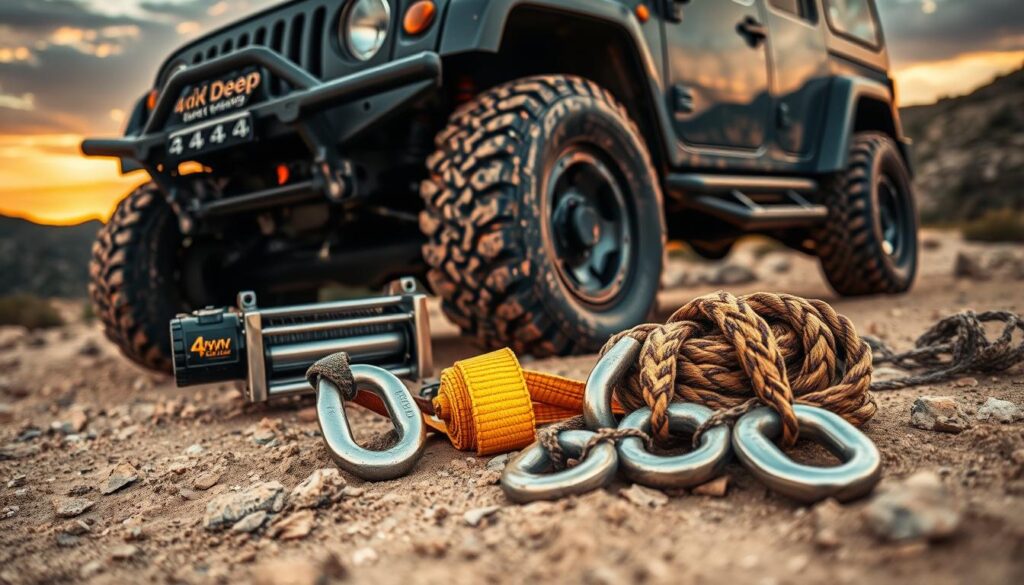
Proper Usage Techniques
Knowing how to use recovery gear safely is key. Always read the instructions before you start. Make sure the gear fits your vehicle and the terrain.
When using tracks, place them right and attach them securely. For chains, wrap them around tires or axles as the maker says. Never use damaged or worn-out recovery equipment, as it can fail and cause harm or damage.
Avoiding Common Mistakes
Don’t underestimate the terrain or overestimate your gear’s power. Always think about the situation and pick the right gear. For example, using recovery techniques for sand can make things safer.
- Never go over the weight limit of your recovery tracks or chains.
- Stay away from open flames or sparks when using recovery gear.
- Make sure everyone is out of the way to avoid getting hurt.
Emergency Preparations
Even with precautions, emergencies can happen. Being ready is important for dealing with them well. Keep a first-aid kit and know basic first aid. Also, make sure your vehicle has a way to communicate, like a two-way radio or satellite phone, when you’re in remote areas.
| Emergency Situation | Preparation Tips |
|---|---|
| Equipment Failure | Carry spare parts and know basic repair techniques. |
| Accidents or Injuries | Have a first-aid kit on hand and know basic first aid. |
| Getting Lost | Equip your vehicle with a GPS device and a map. |
By following these safety tips and being ready, you can lower the risks of using recovery equipment. Always put safety first when off-roading.
Conclusion: Finding the Right Recovery Solution
Choosing the right recovery solution for your 4WD vehicle depends on several factors. These include your vehicle’s specifications, the terrain you’ll be driving in, and your personal preferences. Understanding the benefits and features of recovery tracks and chains helps you make an informed decision.
Selecting the Best Gear for Your Vehicle
When picking recovery gear, think about what’s best for your SUV. Look for durable traction aids that are safe and effective. Consider the weight capacity, ease of use, and storage needs to make the right choice.
Investing in Quality Recovery Equipment
Quality recovery gear is key for reliable and safe performance. Brands like MAXTRAX and Smittybilt offer top-notch recovery tracks and chains for 4WD vehicles. By choosing reputable brands and following maintenance and usage guidelines, you’ll have a successful recovery when needed.
FAQ
What are the best recovery tracks for4WD vehicles?
MAXTRAX, TRED Pro, and Smittybilt X2O are top picks for 4WD recovery tracks. They’re tough and work well in different off-road settings.
How do I choose between recovery tracks and chains?
Choosing between tracks and chains depends on the terrain and your vehicle. Tracks are good for soft ground like sand or mud. Chains are better for rocky or icy areas.
What features should I look for in recovery gear?
Look for recovery gear that’s strong, easy to use, and portable. It should also handle tough off-road conditions well.
How do I maintain my recovery equipment?
Keep your recovery gear clean and check your chains for wear. Store it right to avoid damage and keep it reliable.
What are some common issues with recovery tracks and chains?
Issues include damage from rough terrain, rust, and misuse. Regular care and correct use can help avoid these problems.
Are there any safety tips for using recovery equipment?
Yes, use your gear as directed, avoid common mistakes, and be ready for emergencies. Always check the manual and be cautious.
Can I use recovery tracks in snowy conditions?
Recovery tracks can work in some snow, but chains or snow socks might be better for heavy snow. They offer more grip.
How do I store my recovery gear when not in use?
Keep your gear dry and clean, away from sunlight and moisture. Check it for damage before storing.

